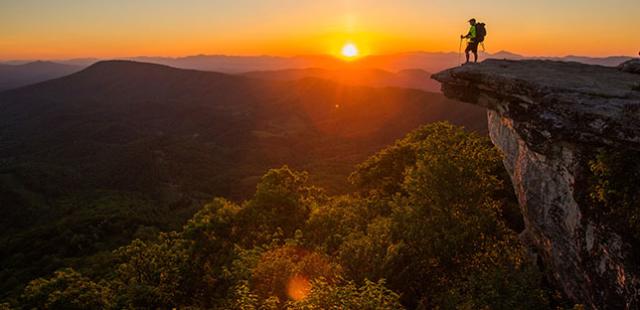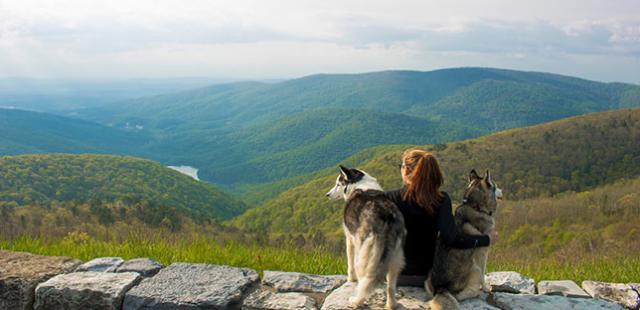This article is the first in a series commemorating the American Evolution – Virginia to America 1619-2019 .
Virginia’s Capital Trail is a scenic 52-mile paved bike and pedestrian path spanning 400 years of American history and linking Virginia’s current State Capital in Richmond, an architectural masterpiece designed by Thomas Jefferson, with its predecessors in Colonial Williamsburg and Jamestown, the birthplace of American democracy. With numerous entrance points and attractions throughout its course – from Richmond’s booming culinary scene, to the James River plantations below the Fall Line, to the charms of Colonial Williamsburg’s living museum, to the archeological walking tours of Historic Jamestowne and the adjoining full-scale interpretive model of Jamestown Settlement – the Virginia Capital Trail proves that Virginia truly is for History Lovers. Throughout the trail, visitors are able to engage in rich experiences that trace the roots of American democracy from the Commonwealth’s earliest days as a budding colony to Virginia’s leading role in forging the country’s hard fought independence from Great Britain.PLANTING THE SEEDS OF DEMOCRACY
 Replicas of the 1607 ships, Susan Constant, Discovery and Godspeed, at Jamestown Settlement.
Replicas of the 1607 ships, Susan Constant, Discovery and Godspeed, at Jamestown Settlement.
Launched in 1607, the Virginia Colony marked the dawn of the British Empire. From conception, the colonization of Virginia was a for-profit enterprise. Those invested in the Virginia Company were categorized as either “Adventurers in purse” or “adventurers in person.” The former were financial investors, while the latter staked life and limb (a bet many of them lost) to settle the New World.
Initially, the adventurers of purse tended to be investors who remained in England in hopes of making handsome profits from the transatlantic diamond in the rough. This endeavor was heartily encouraged by King James I as England’s resources were badly depleted following years of war with Spain. The virgin resources of the New World colony were a tempting opportunity for those in the mother country to fill their purses with proceeds from an untapped and unspoiled wilderness. It was sold as easy pickings.
On the other hand, the adventurers of person were almost evenly divided into two categories: gentlemen and laborers. Those designated as “gentleman,” presumably sent to provide leadership and a whiff of civility. Added to this group was a six-man Council responsible for providing the rule of law. The other half was drawn from what was considered the “lower orders” – both highly skilled craftsmen and unskilled laborers. A quick scan down the list of settlers reveals the thinking behind what investors deemed necessary to get the colony off the ground: six carpenters, a bricklayer, a blacksmith, a tailor, a sailor, a barber and a preacher. The remaining 13 adult men were classified simply as “laborers” – lower-skilled jacks-of-all-trades with strong backs who with oversight could pitch in on the less technical tasks. Collectively, they served as a construction crew charged with building out the infrastructure for a later influx of settlers.
A HARSH DOSE OF REALITY
It was an inauspicious beginning. With gentlemen comprising too high a ratio among the settlers, the colony was top-heavy, illustrating the Virginia Company’s highly unrealistic expectations for easy gains. Recognizing the illogic of this approach, one plainspoken member of council, the legendary John Smith, sent a self-proclaimed “rude” letter back to London imploring for more laborers to swell the colony’s ranks with “carpenters, husbandmen, gardiners, fisher men, blacksmiths, masons and diggers up of trees roots” instead of more of those with “weake and unskilfull bodies” if the investors were to “looke for any profitable returnes.”
The re-created colonial fort at Jamestown Settlement blanketed in snow.
Against all odds, the Jamestown Colony survived weather, disease, starvation and attacks from the native population, and by 1612 a new highly sought raw product from America had taken Europe by storm: tobacco. Virginia offered the ideal means of production in a seemingly limitless supply of fertile soil and a perfect climate. What it lacked was people.POLITICAL POWER ROOTED IN PROPERTY OWNERSHIP
By 1619, investors in the colony began recruiting a new class of settlers, farmers who could cultivate the rich lands along either bank of the James River for the propagation of the tobacco. However, the Virginia Company needed to provide a carrot to lure them. The first was the opportunity for land ownership through the headright system that promised colonists 50 acres of land for each new settler whose passage they paid (new emigrants could also claim one headright for themselves). The second, attendant to the first and rooted in English common law, landownership entitled these settlers to a representative voice in local governance.
A historical interpreter hoes tobacco outside the re-created fort at Jamestown Settlement.
The Virginia Company appointed a new governor in 1618, the freshly knighted Sir George Yeardley. The 32-year-old arrived in Virginia on The George on April 29, 1619 (exactly three months after setting sail) with more than a vested interest in Virginia. He had patented 1,000 acres of land he dubbed Flowerdew Hundred in honor of his wife, Temperance Flowerdew’s, financially powerful family, plus an additional 1,000 acre tract on Mulberry Island near present-day Newport News. Yeardley’s stake was also highly personal. He had been part of a horribly ill-fated voyage 10 years earlier on the Sea Venture intended to supply the colony but shipwrecked off Bermuda (the media sensation in England aroused by news of the shipwreck inspired Shakespeare to write The Tempest). When Yeardley finally arrived at Jamestown that December, he and his fellow crewmembers found most of the colonists dead from a combination of sickness, starvation and Indian attack. Ironically, Temperance was one of the remaining survivors at Jamestown, having somehow endured the awful “Starving Time.” Yeardley had also been appointed deputy-governor of Virginia from 1616 – 1617, in which role he successfully negotiated a treaty with the Indians.AMERICA’S FIRST ELECTED LEGISLATURE
In addition to a cadre of mostly hand-picked emigrants, including Temperance, Yeardley brought with him a lengthy document from London titled “Virginia Company Instructions to George Yeardley,” commonly called “The Great Charter.” Honoring the “commission” in the document to create “a laudable form of government,” Yeardley called into session the first democratically elected legislative body in the New World. The Virginia Assembly was a bicameral body comprised of a lower house – the 22 members of the House of Burgesses locally elected from the colony’s 10 districts – and an upper house made up of Governor Yeardley and his appointed Council. (An interesting aside: a group of Polish craftsmen recruited to the colony was prohibited from voting, prompting the workers to stage the first labor strike in America on June 30, 1619, compelling leaders to yield to their demands.) The Assembly convened in June in the brick Jamestown Memorial Church. In addition to reflecting the priorities of the Virginia Company, the first laws enacted paint a fascinating portrait of everyday life in the budding frontier colony. The Assembly established the price of tobacco for trade to England, but that falls well down the list, far below one of the initial laws designed to curtail idleness, gaming, drunkenness and “excess of apparel” (given the limited resources, one can only imagine what get-ups some colonists were adopting). Agricultural measures prescribed the quantities of corn, mulberries, silk flax, hemp and grapes landowners should cultivate. Not surprisingly, several laws addressed Indian affairs, revealing an overarching policy of mollification and appeasement. One measure pragmatically encouraged vetting and integrating “worthy” Indians into the society of the colonists, while a second urged evangelistic work among local tribes. Still a third threatened punishment against anyone harassing or causing injury to Indians. Reflecting the chronic labor shortage, one law prohibited attempts to poach servants or tenants from another landholder.
The Assembly convened in June in the brick Jamestown Memorial Church. In addition to reflecting the priorities of the Virginia Company, the first laws enacted paint a fascinating portrait of everyday life in the budding frontier colony. The Assembly established the price of tobacco for trade to England, but that falls well down the list, far below one of the initial laws designed to curtail idleness, gaming, drunkenness and “excess of apparel” (given the limited resources, one can only imagine what get-ups some colonists were adopting). Agricultural measures prescribed the quantities of corn, mulberries, silk flax, hemp and grapes landowners should cultivate. Not surprisingly, several laws addressed Indian affairs, revealing an overarching policy of mollification and appeasement. One measure pragmatically encouraged vetting and integrating “worthy” Indians into the society of the colonists, while a second urged evangelistic work among local tribes. Still a third threatened punishment against anyone harassing or causing injury to Indians. Reflecting the chronic labor shortage, one law prohibited attempts to poach servants or tenants from another landholder.

